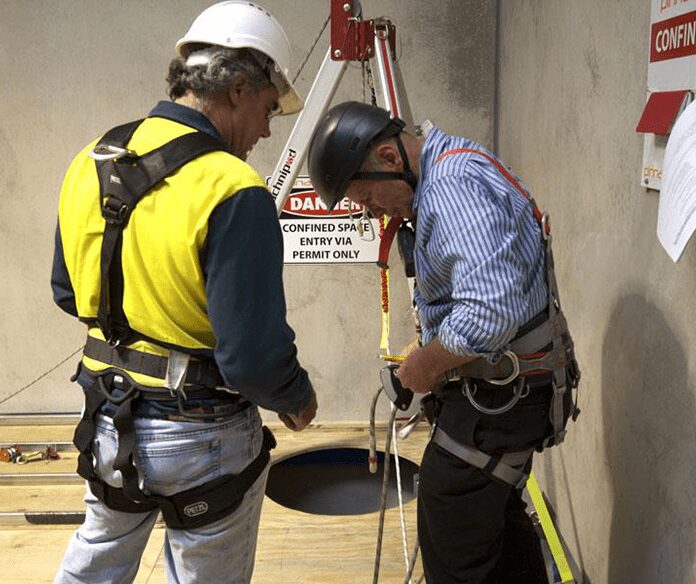Ensuring Safety in Confined Spaces

Ensuring Safety in Confined Spaces: Best Practices for Canadian Job Sites
Confined spaces present unique challenges and hazards that require careful attention and adherence to safety protocols on Canadian job sites. Whether it’s maintenance work in industrial facilities, construction projects, or utility maintenance, working in confined spaces demands a high level of preparation, training, and vigilance to mitigate risks effectively. This article provides comprehensive guidance on how to work safely in confined spaces on Canadian job sites, emphasizing regulatory compliance, hazard identification, and precautionary measures.
Understanding Confined Spaces and Regulations: In Canada, a confined space is defined as an enclosed or partially enclosed area that is not designed for continuous human occupancy, has limited means of entry and exit, and may pose risks to workers due to its configuration, atmosphere, or other factors. Examples include tanks, silos, tunnels, and manholes. Legislation such as the Occupational Health and Safety Act, as well as specific regulations and standards, govern confined space work in Canada. Employers have a legal obligation to identify confined spaces in the workplace, assess associated risks, and implement controls to ensure worker safety.
Pre-Entry Procedures and Hazard Assessment: Before entering a confined space, thorough planning and hazard assessment are essential to identify potential risks and implement appropriate control measures. This involves conducting a comprehensive assessment of the confined space’s atmosphere, physical hazards, and any other potential dangers such as toxic gases, oxygen deficiency, or engulfment hazards. Atmospheric testing should be performed using calibrated gas detection equipment to ensure that oxygen levels are within safe limits and that no hazardous substances are present.
Additionally, employers must establish effective entry procedures, including obtaining necessary permits, implementing lockout/tagout procedures, and providing appropriate personal protective equipment (PPE) such as respiratory protection, harnesses, and fall protection gear. Adequate lighting, ventilation, and communication systems should also be in place to facilitate safe entry and rescue operations if needed.
Training and Competency: Workers involved in confined space operations must receive comprehensive training to recognize hazards, use specialized equipment, and follow established procedures effectively. Training should cover topics such as confined space identification, atmospheric monitoring, emergency response, and the proper use of confined space entry equipment such as lifelines, harnesses, and gas detectors. Employers are responsible for ensuring that workers are adequately trained and competent to perform confined space work safely.
Continuous Monitoring and Communication: Once work in a confined space begins, continuous monitoring and communication are critical to maintaining safety. Entrants and attendants must remain in constant contact using communication devices such as two-way radios or signaling systems. Entrants should be equipped with gas detectors and other monitoring equipment to continuously assess atmospheric conditions and alert personnel to any changes or hazards.
Moreover, regular check-ins and periodic reassessments of the confined space environment are essential to ensure that conditions remain safe throughout the duration of the work. If any unexpected hazards or changes occur, work should be stopped immediately, and appropriate corrective actions taken before resuming operations.
Emergency Preparedness and Rescue: Despite thorough planning and precautions, emergencies can still occur in confined spaces, necessitating swift and effective rescue procedures. Employers must develop and implement an emergency response plan that outlines procedures for rescuing workers in distress, including communication protocols, rescue equipment, and trained rescue personnel. Rescue teams should be adequately trained and equipped to respond to various scenarios, such as confined space entry accidents, medical emergencies, or hazardous substance releases.
Additionally, employers should conduct regular drills and simulations to test the effectiveness of their emergency response plans and ensure that all personnel are familiar with their roles and responsibilities during an emergency.
Post-Entry Procedures and Debriefing: After completing work in a confined space, it is essential to follow proper post-entry procedures to ensure that all workers safely exit the space and that equipment is properly decontaminated and secured. This includes conducting a thorough post-entry evaluation to assess the effectiveness of control measures, document any incidents or observations, and identify opportunities for improvement.
Furthermore, a debriefing session should be held to review the confined space entry process, discuss any issues or concerns that arose during the work, and identify lessons learned for future operations. This feedback loop is critical for continuous improvement and ensuring that best practices are consistently applied on Canadian job sites.
Working safely in confined spaces is a complex endeavor that requires careful planning, thorough training, and strict adherence to established procedures and regulations. By prioritizing hazard identification, effective communication, and emergency preparedness, Canadian employers and workers can mitigate risks and ensure that confined space operations are conducted safely and efficiently. Through ongoing training, monitoring, and evaluation, the goal of zero incidents in confined spaces can be achieved, creating safer work environments for all.
Categories
- Aerial Lift
- ATV Training
- Bear Awareness
- Chainsaw Training
- Confined Space
- Defensive Driving
- Forklift Training
- Lockout Tagout
- Online Safety Training
- Overhead Crane
- Pipeline Construction Safety Training
- Propane Handling
- Safety Training Benefits
- Scissor Lift
- Skid Steer Training
- Space Awareness
- TDG
- Telehandler Forklift
- Traffic Control
- Train the Trainer course
- Training Course
- Uncategorized
- WHMIS
- Workplace Harassment and Violence Preventiont
